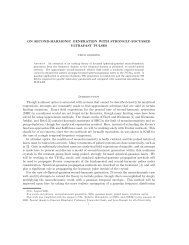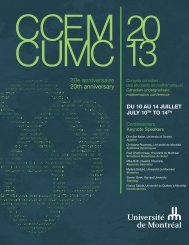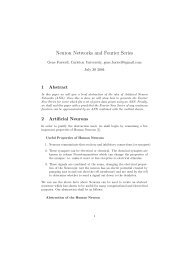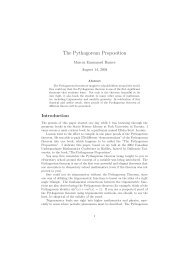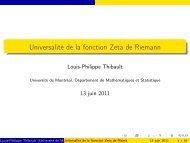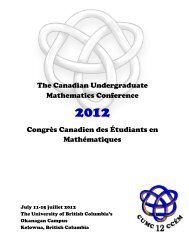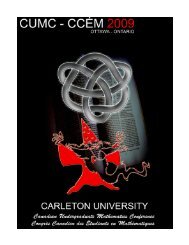booklet - CUMC - Canadian Mathematical Society
booklet - CUMC - Canadian Mathematical Society
booklet - CUMC - Canadian Mathematical Society
Create successful ePaper yourself
Turn your PDF publications into a flip-book with our unique Google optimized e-Paper software.
SPECTRALLY ARBITRARY AND COMPANION MATRICESBRYDON EASTMANRecently patterns of matrices have become popular topics of study. Spectrally arbitrarypatterns are matrix patterns that can realize matrices with any possible set ofeigenvalues. We investigate sparse patterns and compare our results with existing researchon spectrally arbitrary patterns and with recent results on companion matriceswhile highlighting some potential benefits to numerical algorithms.COVERING SPACES: UNBRANCHED AND BRANCHEDCHANGHO HANIn mathematics, one considers "bigger" object than given mathematical object tostudy the original object. For example, for polynomials on real numbers, one insteadconsiders complex numbers to study polynomials.The purpose of this talk is to use this principle on other problems. First, we will goover "Covering Space" (unbranched), which is a space constructed from a given topologicalspace (eg. circle). We will use this space to prove Fundamental Theorem ofAlgebra and why angle function on circle is not well-defined. Then, there is a notion ofbranched covering space of complex plane, which can answer analytic question abouthow multivalued functions (eg. square root function) on a complex plane should behave.It turns out that we end up constructing various Riemann surfaces, which looklike several connected doughnuts.We will use pictures to investigate both objects. It is better if you know some basictopology, but I will explain any necessary topology via pictures.Required Background: Complex numbersA LOOK AT ROTH’S THEOREM - AN APPLICATION OF FOURIER ANALYSIS IN NUM-BER THEORYCHAO HSIEN (JASON) LINIn 1936, Erdos and Turan conjectured that for any natural number k ≥ 1 and realnumber 0 < δ < 1, there exists N ∈ N such that for any subset A ⊂ {1, 2, . . . , N} with|A| ≥ δN, A contains k numbers in an arithmetic progression. The conjecture was notsettled until 1975, a testament to the difficulty of the task at hand. We will look atthe special case k = 3, resolved by Klaus Roth in 1953. The proof presented will beanalytic in nature - illustrating the principle that, with the appropriate transformation,combinatorial questions can admit elegant analytic solutions.MODELING OF CONTACT LINES IN FLUID FLOWSCHENGZHU XUThis work is concerned with the recent model proposed by E.S. Benilov and M.Vynnycky in J. Fluid Mech. (2013), who examined the behavior of contact lines with a180-degree contact angle, in the context of two-dimensional Couette flows. The modelis given by a fourth order linear advection-difusion equation, with an unknown speed20



